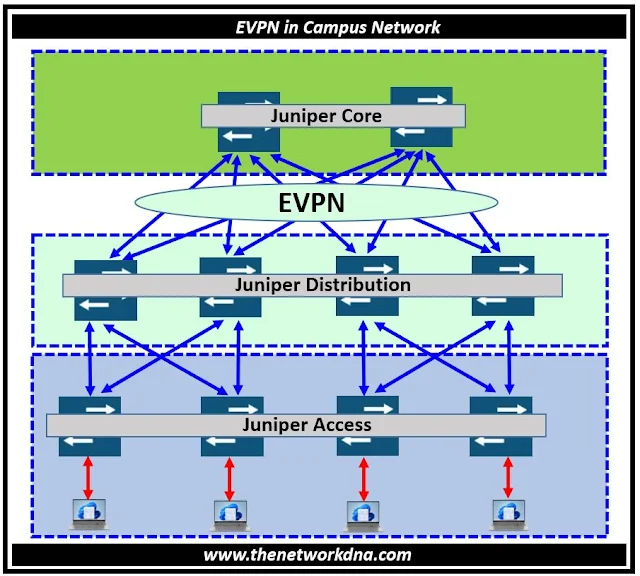EVPN vs LISP - Campus Networks
EVPN vs LISP - Campus Networks
Why we are here to discuss EVPN vs LISP protocol. You may see for the campus network Cisco uses LISP protocol while Juniper uses EVPN. This is an initial article and we will come up with more detailed comparison in future.
What is your thoughts, which one is better.. not sure but we can talk about both these one by one as below.
What is EVPN?
EVPN (Ethernet Virtual Private Network), enables virtualized Ethernet communication between various network devices. Data center and service provider networks frequently employ EVPN to offer effective and scalable network connection.
EVPN provides several benefits over traditional Layer 2 VPN technologies, such as Virtual Private LAN Service (VPLS). One of the main benefits of EVPN is that it enables multi-tenancy, where multiple customers or tenants can share the same physical infrastructure while maintaining separate and secure virtual networks.
EVPN also provides more efficient use of network resources and better scalability compared to traditional Layer 2 VPN technologies.
So how it looks like in the campus infrastructure as used by Juniper Networks
 |
| Fig 1.1- Juniper Campus Network |
Establishing and connecting campuses with data centers and public clouds can be done effectively and scalable with an EVPN-VXLAN campus network. Logical Layer 2 networks can be established over a Layer 3 underlay network using the VXLAN overlay with an EVPN control plane. If you need to extend your campus network quickly, a collapsed core design is perfect for you.
An architecture with a collapsed core is simpler to set up and maintain. By offering multihoming capabilities from the access layer to the collapsed core layer and an L3 IP fabric from the collapsed core to the network core, EVPN multihoming removes the need for Spanning Tree Protocol (STP) throughout the campus network.
What is LISP Protocol ?
LISP or so called as Locator identification/Separator Protocol separates the region and the identifier of the community hosts, hence making it viable for digital machines to move across subnet limitations whilst maintaining their IP deal with.
LISP is composed of a community architecture and a set of protocols that permit new semantics for IP addressing by way of creating namespaces
- Endpoint Identifiers (EIDs): EIDs are assigned to give up hosts.
- Routing Locators (RLOCs) : RLOCs are assigned to routers that make up the worldwide routing device.
 |
| Fig 1.2- Cisco Campus Network |
Although, we are not talking about all the terms used in the Cisco SD-Access environment where they use EIDs, RLOCs, ITRs and Map servers.
EVPN vs LISP : Use Cases
Mobility and Endpoint Roaming:
- LISP is often preferred in campus networks due to its robust handling of mobility. As organizations transition to Wi-Fi-only infrastructures or adopt Wi-Fi-first strategies, endpoint mobility becomes critical. LISP excels in scenarios where endpoints (user IP/MAC addresses) move frequently across access points.
- EVPN, originally designed for data centers, also supports mobility but has limitations. In EVPN, every VTEP (VXLAN Tunnel Endpoint) must be aware of all endpoints within the VRFs they manage. When a device moves to another VTEP, control plane messages are exchanged to update the network. However, this process can burden the network, especially in dynamic environments like campuses with mobile devices
Control Plane and Scaling:
- LISP scales well and provides optimizations for mobility. It can run on low-end, constrained switches. LISP’s control plane separates the location (routing locator) from the identity (endpoint identifier), making it suitable for scenarios with high churn rates.
- EVPN, based on BGP, is powerful and flexible but requires a converged network. It floods control plane traffic when endpoints move, which can strain the network. While EVPN can handle significant updates (up to 400,000 daily updates), it may face challenges in highly mobile environments
Latency and MAC Moves:
- Both LISP and EVPN aim to minimize latency during endpoint roaming. When an end-user NIC moves from one access point to another:
- In EVPN, the MAC move procedure starts when the NIC reappears at the new attachment point. The network forwards traffic to the new location, minimizing disruption.
- In LISP, similar principles apply. The network notifies that the MAC address is now reachable via another egress switch.
- Latency spikes following roaming events are unlikely to be attributed solely to MAC moves. Instead, other factors (e.g., buffering) may contribute to latency.
EVPN vs LISP : Differences
Here is the table showing the difference between LISP and EVPN while using in the campus environment.
| Aspect | LISP | EVPN |
|---|---|---|
| Stands For | Locator identification/Separator Protocol | Ethernet Virtual Private Network |
| Underlying Protocol | IP,UDP | BGP (Border Gateway Protocol) |
| Tunnel Type | VXLAN, GRE | VXLAN |
| Mapping | EID to RLOC | MAC address to IP address |
| Scalability | Good but Complex | Highly Scalable and efficient |
| Mobility | Supports Mobility for mobile devices | Supports mobility for endpoints |
| Security | Requires additional measures | Integrates with BGP security |
| Multicast Support | Limited | Efficient |
| Deployment | Less Common & Complex | Widely adopted, simpler deployment |
Continue Reading...







